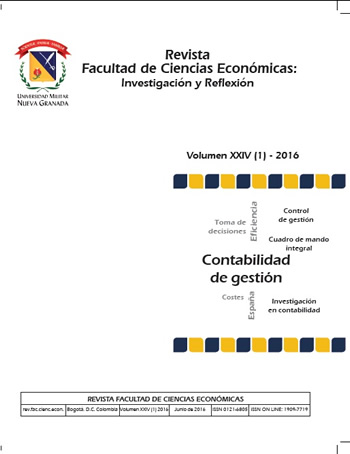Factores contextuales implicados en la elección del sistema de información interno
Resumen
El objetivo del presente trabajo es identificar los factores contextuales que potencialmente influyen o están implicados en la elección y eficiencia del sistema de información interno. La investigación planteada obedece a un estudio explicativo. Se centra en un solo sector económico, debido a que permite acotar los efectos derivados de las condiciones de mercado, del ciclo económico y de la tecnología de producción. El sector elegido ha sido el hotelero. Se concluye que el rendimiento de una organización depende del acoplamiento entre la estrategia, la estructura y el sistema de información interno implantado en la organización.Descargas
Lenguajes:
esReferencias bibliográficas
Abdel-Maksoud, A.B. (2004). Manufacturing in the UK: contemporary characteristics and performance indicators. En: Journal of Manufacturing Technology Management, 15: 155-171.
Abernethy, M.A. & Bouwens, J. (2005). Determinants of accounting innovation implementation. En: Abacus, 41: 217–239.
Baines, A. & Langfield-Smith, K. (2003). Antecedents to management accounting change: a structural equation approach. En: Accounting, Organizations and Society, 28 (7-8): 675-698.
Banker, R.D.; Potter, G. & Schroeder, R.G. (1993). Reporting manufacturing performance measures to workers: an empirical study. En: Journal of Management Accounting Research, 5: 33-55.
Bastian, E. & Muchlish, M. (2012). Perceived Environment Uncertainty, Business Strategy, Performance Measurement Systems and Organizational Performance. En: Procedia Social and Behavioral Sciences, 65 (3): 787–792.
Becerra, M.; Santaló, J. & Silva, R. (2013). Being better vs. being different: Differentiation, competition, and pricing strategies in the Spanish hotel industry. En: Tourism Management, 34: 71–79.
Bisbe, J. & Otley, D. (2004). The effects of the interactive use of management control systems on product innovation. En: Accounting, Organizations and Society, 29 (8): 709–737.
Brenes, E.; Montoya, D. & Ciravegna, L. (2014). Differentiation strategies in emerging markets: The case of Latin American agribusinesses. En: Journal of Business Research, 67 (5): 847–855.
Bright, J.; Davies, R.E.; Downes C.A. & Sweeting, R.C. (1992). The deployment of costing techniques and practices: a UK study. En: Management Accounting Research, 3 (3): 201-211.
Burkert, M.; Davila, A.; Mehta, K. & Oyon, D. (2104). Relating alternative forms of contingency fit to the appropriate methods to test them. En: Management Accounting Research, 25 (1): 6-29.
Burns, T. & Stalker, G.M. (1961). The management of innovation. Tavistock, London.
Chapman, C.S. (1998). Accountants in organizational networks. En: Accounting, Organizations and Society, 23 (8): 737–766.
Chenhall, R.; Hall, M. & Smith, D. (2013). Performance measurement, modes of evaluation and the development of compromising accounts. En: Accounting, Organizations and Society, 38 (4): 268–287.
Chenhall, R.H. (2003). Management control systems design within its organizational context: finding from contingency-based research and directions for the future. En: Accounting, Organizations and Society, 28 (2-3): 127-168.
Chenhall, R.H. & Langfield-Smith, K. (1998a). Adoption and benefits of management accounting practices: an Australian study. En: Management Accounting Research, 9 (1): 1- 19.
Chenhall, R.H. & Langfield-Smith, K. (1998b). The relationship between strategies priorities, management techniques and management accounting: an empirical investigation using a systems approach. En: Accounting, Organizations and Society, 23 (3): 243-264.
Chenhall, R.H. & Morris, D. (1986). The impact of Structure, Environment, and Interdependence on the Perceived Usefulness of Management Accounting Systems. En: The Accounting Review, 61: 16-35.
Chin, W.W. (1998). The Partial Least Squares Approach to Structural Equation Modeling, en G.A. Marcoulides [ed.]: Modern Methods for Business Research, 295-336. Mahwah, NJ: Lawrence Erlbaum Associates, Publisher.
Chong, V.K. & Chong, K.M. (1997). Strategic choices, environmental uncertainty and SBU performance: a note on the intervening role of management accounting systems. En: Accounting and Business Research, 27 (4): 268–276.
Christensen, J. & Demski, J. (2003). Accounting Theory—An Information Content Perspective. New York: McGraw-Hill.
Claver-Cortés, E.; Molina-Azorín, J.F. & Pereira-Moliner, J. (2007). Competitiveness in mass tourism. En: Annals of Tourism Research, 34: 727–745.
Cooper, R. (1996). Costing techniques to support corporate strategy: evidence from Japan. En: Management Accounting Research, 7 (2): 219-246.
Cuadrado-Roura, J.R & Maroto-Sánchez, A. (2012). Análisis del proceso de especialización regional en servicios en España. En: Eure, 33: 5-34.
Cugueró-Escofet, N. & Rosanas, J.M. (2013). The just design and use of management control systems as requirements for goal congruence. En: Management Accounting Research, 24 (1): 23-40.
Donaldson, L. (2001). The contingency theory of organizations (Ed. Sage, California).
Drazin, R. & Van de Ven, A.H. (1985). Alternative forms of fit in Contingency Theory. En: Administrative Science Quarterly, 30: 514-539.
Emmanuel, C.; Otley, D. & Merchant, K. (1991). Accounting for Management Control. Londres Chapman&Hall. Segunda edición impresa.
Fullerton, R.R. & McWatters, C.S. (2002). The role of performance measures in relation to the degree of JIT implementation. En: Accounting, Organizations and Society, 27 (8): 711–735.
Fuchs, P.H.; Mifflin, K.E.; Miller, D. & Whitney, J.O. (2000). Strategic integration: competing in the age of capabilities. En: California Management Review, Spring: 118–147.
Garrigos-Simon, F.J. & Narangajavana, Y. (2005). Competitive strategies and performance in Spanish hospitality firms. En: International Journal of Contemporary Hospitality Management, 17: 22-38.
Gefen, D.; Straub, D.W. & Boudreau, M.C. (2000). Structural equation modelling and regression: guidelines for research practice. En: Association for Information Systems, 4 (7): 1-70.
Gerdin, J. (2005). Management accounting system design in manufacturing departments: an empirical investigation using a multiple contingencies approach. En: Accounting, Organizations Society, 30 (2): 99-126.
González‐Benito, J. (2010). Supply strategy and business performance: An analysis based on the relative importance assigned to generic competitive objectives. En: International Journal of Operations & Production Management, 30 (8): 774–797.
Gordon, L.A. & Miller, D. (1976). A contingency framework for the design of accounting information systems. En: Accounting, Organizations and Society, 1 (1): 59–69.
Govindarajan, V. (1984). Appropriateness of accounting data in performance evaluation: and empirical examination of environmental uncertainty as an intervening variable. En: Accounting, Organizations and Society, 9 (2): 125-136.
Green, K.; Covin, J. & Slevin, D. (2008). Exploring the relationship between strategic reactiveness and entrepreneurial orientation: The role of structure–style fit. En: Journal of Business Venturing, 23 (3): 356–383.
Guilding, C.; Carvens, K.S. & Tayles, M. (2000). An international comparison of strategic management accounting practices. En: Management Accounting Research, 11 (1): 113-135.
Henri, J.F. (2006). Organizational culture and performance measurement systems. En: Accounting, Organizations and Society, 31: 77-103.
Hodge, B.J.; Anthony, W.P. & Gales, L.M. (2003). Teoría de la organización. Un enfoque estratégico. Pearson. Prentice Hall, 6º Ed.
Hunt, S.D. & Morgan, R.M. (1995). The Comparative Advantage Theory of Competition. En: Journal of Marketing, 59 (April): 1-15.
IET Instituto de Estudios Turísticos (2012), http://www.iet.tourspain.es/es-ES/Paginas/default.aspx.
Jermias, J. & Gani, L. (2004). Integrating business strategy, organizational configurations and management accounting systems with business unit effectiveness: a fitness landscape approach. En: Management Accounting Research, 15 (2): 179-200.
Johnson, H.T. & Kaplan, R.S. (1987). Relevance lost the rise and fall of management accounting. Boston MA: Harvard Business School Press.
Jorgensen, B. & Messner, M. (2009). Management control in new product development: the dynamics of managing flexibility and efficiency. En: Journal of Management Accounting Research, 21 (1): 99–124.
Kajüter, P. & Kulmala, H.I. (2005). Open-book accounting in networks potential achievements and reasons for failures. En: Management Accounting Research, 16 (2): 179-204.
Kanter, R. (2001). Evolve! Succeeding in the Digital Culture of Tomorrow. Harvard Business School Press, Boston.
Kaplan, R.S. (1984). Yesterday´s accounting undermines production. En: Harvard Business Review, July-August: 95-101.
Keidel, R.W. (1994). Rethinking organizational design. En: Academy of Management Executive, 8 (4):12–17.
Khandwalla, P. (1977). Design of organizations, New York, Harcourt Brace Jovanovich.
Koen, C. (2004). The dialectics of globalizations: what are the effects for management and organization in Germany and Japan? En: Research in International Business and Finances, 18: 173-197.
Laitinen, E.K. (2014). Influence of cost accounting change on performance of manufacturing firms. En: Advances in Accounting, 30 (1): 230–240.
Langfield-Smith, K. (1997). Management control systems and strategy: a critical review. En: Accounting, Organizations and Society, 22 (2): 207-232.
Lawrence, P.R. & Lorsch, J.W. (1967). Organizations and environment. Boston. M.A. Harvard Business School Press.
Macintosh, N. (1994). Management accounting and control systems: an organizational and behavioral approach. Chichester, UK: John Wiley.
Mahlendorf, M.D.; Kleinschmit, F. & Perego, P. (2014). Relational effects of relative performance information: The role of professional identity. En: Accounting, Organizations and Society, 39 (5): 331–347.
Mauri, A.G. (2012). Hotel Revenue Management: Principles and Practices. Pearson Italia, Milano-Torino.
McManus, L. (2013).Customer accounting and marketing performance measures in the hotel industry: Evidence from Australia. En: International Journal of Hospitality Management, 33: 140–152.
Miller, D. (1988). Relating Porter’s business strategies to environment and structure: analysis and performance implications. En: Academy of Management Journal, 31(2): 280–308.
Mundy, J. (2010). Creating dynamic tensions through a balanced use of management control systems. En: Accounting, Organizations and Society, 35 (5): 499–523.
Naranjo-Gil, D. & Álvarez-Dardet, C. (2006). El uso del sistema contable de gestión en la implantación de la estrategia: análisis del ajuste contingente. En: Revista Española de Financiación y Contabilidad, 128: 157-179.
Olaru, M.; Maier, D.; Nicoară, D. & Maier, A. (2014). Establishing the basis for Development of an Organization by Adopting the Integrated Management Systems: Comparative Study of Various Models and Concepts of Integration. En: Procedia - Social and Behavioral Sciences, 109: 693–697.
Parthasarthy, R. & Sethi, S.P. (1993). Relating strategy and structure to flexible automation: a test of fit and performance implications. En: Strategic Management Journal, 14: 529–549.
Perera, S.; Harrison, G. & Poole, M. (1997). Customer-focused manufacturing strategy and the use of operations-based non-financial performance measures: a research note. En: Accounting, Organizations and Society, 22 (6): 557–572.
Podsakoff, P.M. & Organ D.W. (1986). Common method biases in behavioral research: a critical review of the literature and recommended remedies. En: Journal of Management, 12: 531-544.
Porter, M.E. (1985). Competitive Advantage: Creating and Sustaining Superior Performance. New York: Free Press.
Puolamäki, E. (2004). Strategic Management Accounting. Constructions in Organizations. Turun Kauppakorkekoulun Julkaisuja. Turku School of Economics and Business Administration Publications.
Rigby, D.K. (2003). Management tools survey 2003; usage up as companies strive to make headway in tough times. En: Strategy & Leadership, 31 (5): 4 -12.
Rigby, D.K. & Bilodeau, B. (2013). Management Tools & Trend 2013. http://bain.com/Images/BAIN_BRIEF_Management_Tools_%26_Trends_2013.pdf.
Ripoll, V. & Urquidi, A.C. (2010). Herramientas de contabilidad de gestión utilizadas en la práctica empresarial: una revisión crítica de los trabajos de investigación. En: Academia. Revista Latinoamericana de administración, 44:1-20.
Sanchez Quiros, I. (2003). Estrategia, estructura y cultura como factores clave de éxito en los hoteles españoles. IX Foro de Finanzas, ACEDE. Navarra.
Shields, M.D.; Kato, Y. & Deng, J. (2000). The design of control systems: test of direct and indirect – effect models. En: Accounting, Organizations and Society, 25 (2): 185–202.
Sim, K.L. & Killough, L.N. (1998). The performance effects of complementarities between manufacturing practices and management accounting systems. En: Journal of Management Accounting Research, 10: 325–346.
Sinkula, J.M.; Baker, W. & Noordewier, T.G. (1997). A Framework for Market-Based Organizational Learning: Linking Values, Knowledge and Behaviour. En: Journal of the Academy of Marketing Science, 25 (Fall): 305-318.
Siti‐Nabiha, A.K. & Scapens, R.W. (2005). Stability and change: an institutionalism study of management accounting change. En: Accounting, Auditing & Accountability Journal, 18 (1): 44-73.
Smith, J.; Yuhchang, H.; Pei, B. & Reneau, J. (2002). The performance effects of congruence between product competitive strategies and purchasing management design. En: Management Science, 48 (7): 866-885.
Thomas, A.S. & Ramaswamy, K. (1996). Matching managers to strategy: Further Tests of the Miles and Snow Typology. En: British Journal of Management, 7: 247-261.
Tuomimem, M. & Möller, K. (1996). Market Orientation: A State of the Art Review, 25th EMAC Annual Conference, Marketing for an Expanding Europe, J. Beracs, A. Baner & J. Simon. (eds.), Budapest, May. Proceedings, 2: 1161-1181.
Van der Voet, J. (2014). The effectiveness and specificity of change management in a public organization: Transformational leadership and a bureaucratic organizational structure. En: European Management Journal, 32, (3): 373–382.
VII Foro de Liderazgo Turístico de Exceltur (2014). El Turismo: Sector clave para reforzar la marca País. 21 de Enero. Madrid. Centro de Convenciones IFEMA.
Weißenberger, B & Angelkort, H. (2011). Integration of financial and management accounting systems: The mediating influence of a consistent financial language on controllership effectiveness. En: Management Accounting Research, 22 (3): 160-180.
Werbel, J. & DeMarie, S. (2005). Aligning strategic human resource management and person–environment fit. En: Human Resource Management Review, 15 (4): 247–262.
Ylinen, M. & Gullkvist, B. (2014). The effects of organic and mechanistic control in exploratory and exploitative innovations. En: Management Accounting Research, 25 (1): 93-112.
Zhanga, D.; Lindermanb, K. & Schroederc, R.G. (2012). The moderating role of contextual factors on quality management practices. En: Journal of Operations Management, 30 (1-2): 12-23.
Zhenga, W.; Yangb, B. & McLeanc, G.N. (2010). Linking organizational culture, structure, strategy, and organizational effectiveness: Mediating role of knowledge management. En: Journal of Business Research, 63 (7): 763-77.












